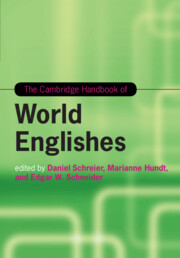Book contents
- The Cambridge Handbook of World Englishes
- Cambridge Handbooks in Language and Linguistics
- The Cambridge Handbook of World Englishes
- Copyright page
- Dedication
- Contents
- Figures
- Maps
- Tables
- Notes on Contributors
- 1 World Englishes: An Introduction
- Part I The Making of Englishes
- Part II World Englishes Old and New
- Part III Linguistics and World Englishes
- 14 The Global Growth of English at the Grassroots
- 15 Beyond English as a Second or Foreign Language: Local Uses and the Cultural Politics of Identification
- 16 World Englishes in Cyberspace
- 17 World Englishes and Their Dialect Roots
- 18 Lexicography and World Englishes
- 19 The Relevance of World Englishes for Variationist Sociolinguistics
- 20 Multilingualism and the World Englishes
- 21 Unearthing the Diachrony of World Englishes
- 22 Corpus-Based Approaches to World Englishes
- 23 World Englishes from the Perspective of Dialect Typology
- 24 Language Acquisition and World Englishes
- Part IV Current Challenges
- Index
- References
19 - The Relevance of World Englishes for Variationist Sociolinguistics
from Part III - Linguistics and World Englishes
Published online by Cambridge University Press: 16 December 2019
- The Cambridge Handbook of World Englishes
- Cambridge Handbooks in Language and Linguistics
- The Cambridge Handbook of World Englishes
- Copyright page
- Dedication
- Contents
- Figures
- Maps
- Tables
- Notes on Contributors
- 1 World Englishes: An Introduction
- Part I The Making of Englishes
- Part II World Englishes Old and New
- Part III Linguistics and World Englishes
- 14 The Global Growth of English at the Grassroots
- 15 Beyond English as a Second or Foreign Language: Local Uses and the Cultural Politics of Identification
- 16 World Englishes in Cyberspace
- 17 World Englishes and Their Dialect Roots
- 18 Lexicography and World Englishes
- 19 The Relevance of World Englishes for Variationist Sociolinguistics
- 20 Multilingualism and the World Englishes
- 21 Unearthing the Diachrony of World Englishes
- 22 Corpus-Based Approaches to World Englishes
- 23 World Englishes from the Perspective of Dialect Typology
- 24 Language Acquisition and World Englishes
- Part IV Current Challenges
- Index
- References
Summary
Rooted in historical linguistics, variationist sociolinguistics is often concerned with diachrony as reflected in synchronic grammars. World Englishes (WEs), which emerge through particular sociohistorical factors (e.g. colonialization, language contact, mass migration, dialect mixing, etc.), provide an ideal window for examining questions that are central to this mission: the inheritance of shared features, ongoing evolutionary mechanisms, and pathways of innovation as dialects interact and settle within new local linguistic ecologies. These varieties thus extend our knowledge base concerning the underlying mechanisms of language variation and change. In so doing, they enable theoretical and empirical advances through application of the comparative method, exposing the interaction between external social forces and internal linguistic ones on linguist forms and functions. In this chapter, I review variationist research that targets multiple varieties, both in the Inner Circle and, where available, the Outer Circle, to outline the gains that are possible by harnessing the synergistic energies of WEs through a variationist lens.
- Type
- Chapter
- Information
- The Cambridge Handbook of World Englishes , pp. 436 - 458Publisher: Cambridge University PressPrint publication year: 2020
References
- 1
- Cited by

